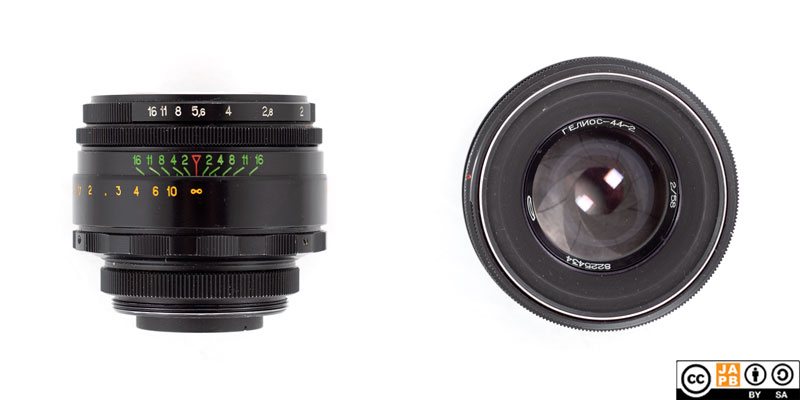Pekka Buttler, 02/2024

Specifications
The table below summarizes the lens’ key specifications (measurements based on pictured sample):
| Brand: | Helios | Lens name | 44-2 |
| Focal length(s)1 | 58 mm | Angle-of-view2 | 40° 28 |
| Maximum Aperture | f/2 | In Production | early 50s-80s |
| Lens mount | M42 | Other available lens mounts | Z39, Pentax K (rare), Start Bayonet3 (rare) |
| Length4 | 46,5 mm | Diameter5 | 60,0 mm |
| Filter ring diameter | 49 mm | Weight | 222 grams |
| Lens element count | 6 | Lens group count | 4 |
| Aperture blades (S/R/C)6 | 8 S | Focus throw | 275 ° |
| Minimum focusing distance | 50 cms | Maximum magnification | 1:x,x |
| Has manual aperture ring | YES | Has Manual focus ring | YES |
| Aperture mechanism type | Preset 7 | Aperture click stops 8 | 2-2.8-4-5.6-8-11-16 |
Further technical notes:
• The pictured sample of the lens is likely from 1982 (see the JAPB article on Soviet serialnumberology).
• Based on the manufacturer logo, this sample was manufactured at the MMZ plant in Minsk (modern day Byelorussia), but identical lenses (same design, same colouring) were produced also at KMZ and the Valdai plant.
• This lens uses a preset aperture mechanism with a eight-bladed aperture.
• The Helios-44 (in its various versions) is likely one of the most serially produced lenses in camera history
Historical notes on the Helios-44
• The Helios-44 is a Soviet remake of the Carl Zeiss Jena Biotar 58 mm f/2 [data sheet]. The development and history of the Biotar are discussed in that article.
• Unlike some sources say, the Helios-44 was not so much an attempt at a 1:1 copy of the Biotar, but the goal of the designers at the Soviet KMZ plant was – from the onset – to simplify the Biotar in the hope of creating a more economical design. The resulting design was initially referred to as the BTK – BioTar Krasnogoski.
• Considering that the Helios-44 was manufactured during several decades, at several plants, and for several mounts, there is bound to be some exceptions, but as a general rule:
• Lenses named Helios-44/Гелиос-44 were offered either for the Start bayonet or for the Z39 (Early Zenit) mount
• Lenses named Helios-44-2/Гелиос-44-2 were equipped with an M42 thread mount.
• Later (after the Z39 and Start Bayonet mount versions were no longer produced) a numbering scheme was instigated wherein Helios-44/Гелиос-44 would be followed by an optional capital letter denoting the mount, an optional hyphen and number and an optional trailing letter or two. Importantly the capital letter K (e.g. Helios-44K-4) would denote a Pentax K mount and a capital letter M (e.g. Helios-44M or Helios-44M-4) would denote an M42 mount. Interestingly the trailing number would sometimes denote a version number but could also be assigned based on the tested optical quality of the lens. A trailing letter M (e.g. Helios-44-3M) would be used to indicate version optimised for use on a macro bellows and a trailing MC would indicate multi-coating (e.g. Helios-44M-7 MC).
• The Helios-44 is loved by many for its ability to produce a swirly bokeh. However, this ability is not uniform and the intensity of that swirlyness differs from one version to another (and even sample-to-sample). Opinions online of which variant is most likely to produce a strong swirl diverge a lot.
• A rather comprehensive (but likely not complete) pictorial inventory of Helios-44 versions can be found on Radojuva.com
Adapting
This lens cannot be used natively on any current SLR or dSLRs. To use it in its native environment, you will need a M42-mount film body. Luckily there are a lot of those still available.
Thanks to being a fully manual lens (manual aperture, manual focus), the lens can be adapted to all mirrorless cameras using a suitable ‘dumb adapter’. Moreover, due to the popularity of the M42 mount, special adapters (helicoid adapters, tilt/shift adapters) are readily available. Alternatively, one can choose to daisy-chain adapters (e.g. M42->Canon EF; Canon EF –> mirrorless) which also opens up a wide range of speed boosters for those photographers that use smaller than full-frame sensors.
Using m42 lenses on dSLRs can also be an easy option, depending on the marque of dSLR.
• Canon EF, Minolta A/Sony A and Pentax K dSLRs are able to mount M42 lenses perfectly using a simple adapter ring. At infinity, the lens also protrudes a bit into the mount, which may limit adaptability on some full-frame dSLR’s.
• Nikon F dSLRs have a long flange focal distance, meaning that adapting M42 lenses necessitates an adapter that uses corrective optics to allow anything close to infinity focus.
Footnotes
- Focal length is (unless stated otherwise) given in absolute terms, and not in Full-frame equivalent. For an understanding of whether a lens is wide/tele, see ‘Angle-of-view’. ↩︎
- Picture angle is given in degrees and concerns the diagonal picture angle. Rule of thumb:
> 90 ° ==> Ultra-wide-angle
70–90 ° ==> Wide-angle
50–70 ° ==> Moderate wide-angle
40–50 ° ==> ‘Standard’ or ‘normal’ lens
20–40 ° ==> Short tele lens
10-20 ° ==> Tele lens
5-10 ° ==> Long tele lens
< 5 ° ==> Ultra-tele lens ↩︎ - The Start was an advanced 1958 SLR that used a proprietary bayonet and a trigger mechanism that is familiar to users of post-war Exakta cameras. ↩︎
- Length is given from the mount flange to the front of lens when focused at infinity. ↩︎
- Diameter excludes protrusions such as rabbit ears or stop-down levers. ↩︎
- S=straight; R=rounded; C=(almost)circular at all apertures. ↩︎
- This lens combines a preset ring with click stops with a clickless manual aperture ring. ↩︎
- Numbers equal aperture values on aperture ring; • intermediate click; – no intermediate click. ↩︎